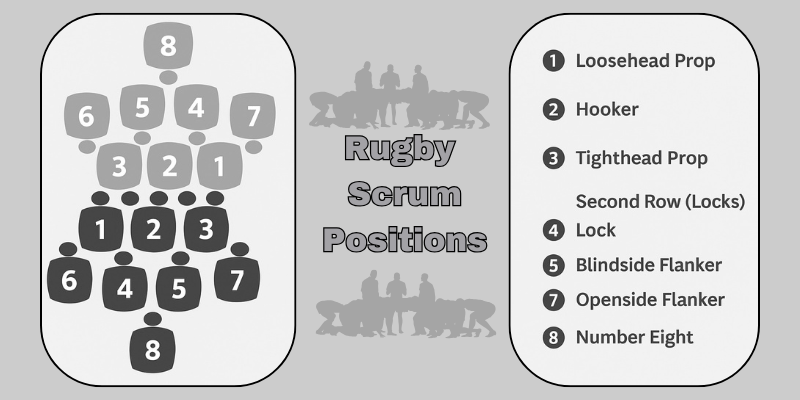A rugby scrum is one of the most iconic and physically intense moments in the game – a true test of power, technique, and teamwork.
In this article, we’ll explain what a scrum is in rugby, how it works, the different positions, the latest scrum rules, and what makes it such an important part of both rugby union and rugby league.
What is a Scrummage in Rugby?
A rugby scrummage, often simply referred to as a scrum, is a structured method of restarting play after minor infringements, such as a knock-on or a forward pass. In this phase, eight players from each team pack together in three tightly formed rows, binding as a unit to create a powerful formation. Once the referee gives the signal, both packs engage and try to drive each other back.
The scrum half rugby position plays a key role here. The scrum-half from the team awarded the scrum feeds the ball into the tunnel between the front rows. The middle players, especially the hooker, then try to win possession by hooking the ball backward with their feet.
In scrums in rugby union, precision and safety really matter. Each set-piece is governed by strict rules to ensure fair play and player protection. At its core, the rugby scrum or scrummage is a physical contest for control of the ball. It demands strength, timing, and coordination — making it one of the most defining and intense parts of the sport.
Rugby Scrum Positions
Understanding rugby scrums starts with knowing each player’s role within the scrum formation and how the different rugby positions in scrum work together to create a strong, coordinated push.

Loosehead Prop – Positioned on the left, nearest the sideline. The loosehead prop provides stability and protects the hooker from opposition pressure. This player needs great strength and balance to withstand the force of contact.
Hooker – The hooker stands in the middle of the front row. Their main job is to use their foot to hook the ball back when it’s put into the scrum. They need to be quick and sharp, because winning the ball often depends on how fast and well they react.
Tighthead Prop – The tighthead prop lines up on the right side of the scrum. This player takes on a lot of pressure from the other team. They need to be strong and have good stamina to hold their ground and help keep the scrum steady.
Locks (Second Row) – Standing directly behind the front row, the locks are usually the tallest players. Their primary role is to generate the driving force for the scrum and “lock” the formation, thereby helping the team gain momentum.
Flankers – Flankers are positioned on each side of the scrum. They’re quick, mobile, and always ready to break from the scrum to attack or defend as soon as the ball is out. Their role is to react fast and support both attack and defense.
Number Eight – The number eight stands at the back of the scrum and is responsible for controlling the ball as it emerges. This player often initiates attacking moves and is key in transitioning from scrum to open play.
How to Win a Scrum in Rugby
A scrum is one of the main parts of rugby, and winning it can give your team a big advantage. However, it’s not just about being strong — it takes timing, teamwork, and good technique. Below are the main things every team needs to focus on to win a scrum.
- Time the hit so all eight players drive at once. One mistimed push can throw off the whole scrum.
- Keep your hips low, core tight, and back flat. It’s easier to drive forward and stay balanced.
- Props support the front, the hooker strikes, locks bring power, and the back row adds control. Everyone doing their part is key.
- A fast and clean hook from the hooker gives your team early control of the ball.
- Don’t collapse, twist, or angle in. Stay square and bind properly to avoid penalties.
- Quick, clear calls help the pack stay in sync and react if the scrum starts to shift.
New Rugby Scrum Rules
Rugby scrum rules change frequently to make the game safer, fairer, and easier to manage. Understanding the rules of rugby scrum is essential for players and coaches, as even small mistakes can result in penalties or lost possession. The latest updates for 2023–2024 focus on improving structure, player safety, and timing during each set-piece.
Scrum Time Limit – Teams have 30 seconds after the referee signals to form and be ready for the scrum. Delays are punished with a free kick for the opposition.
Crouch-Bind-Set Sequence – The referee gives the sequence “Crouch, Bind, Set.” The front rows must only engage after “Set,” or the team will be penalized for early engagement.
Scrum Stability and Safety – The scrum must stay straight and steady before and after the ball is fed. If the scrum wheels more than 90 degrees or collapses, the referee may penalize the team at fault.
Hooker’s Foot – The hooker must strike for the ball as soon as it’s put in. Failing to do so can result in a free kick for the opposition.
Straight Feed – The scrum-half must feed the ball straight into the middle, though they may stand with their shoulder on the midline for safety.
No Early Pushing – Teams cannot push before the ball is fed. Early pushing leads to a penalty.
Offside Lines – Flankers and other players must remain bound and in the scrum until the ball is out.
Listen to the Referee – Players must follow all referee instructions, especially at the end of the scrum. Deliberate delays or collapsing the scrum are penalized.
Player Safety – There’s increased focus on head and neck protection. Referees will stop play at the first sign of danger.
Safety in Rugby Scrum
The rugby scrum isn’t just about power and control — it’s also one of the riskiest parts of the game. Only experienced and well-trained players take positions in the front row because they know how to keep it safe and avoid injuries.
In some matches, especially at the amateur level or when a team has no available front-row replacements, the game continues with a rugby loose scrum. In this version, the players still form the usual scrum shape, but there’s no pushing allowed. The purpose is simply to restart play without the physical contest, reducing injury risk while keeping the game moving.
Referees strictly enforce safety rules, and even minor infractions — such as collapsing or early pushing — can lead to penalties or a player being removed from the game. To help players learn safe and effective techniques, teams often use special scrum machines in training. These drills build strength, timing, and confidence under pressure.
Most Famous and Dominant Scrums in Rugby History
Here are some of the most famous and powerful scrums in rugby history — moments where the pack made all the difference.
| Match/Event | Year | Why It’s Famous |
|---|---|---|
| England vs Australia (RWC Quarter-Final) | 2007 | England’s scrum dominated, winning multiple penalties and controlling the game. |
| Wales vs England (Six Nations) | 2013 | Wales’ scrum crushed England in a 30–3 win, ruining their Grand Slam hopes. |
| Leicester Tigers vs Stade Français | 2001 | Club-level clash with powerful, match-winning scrummaging. |
| France vs New Zealand (RWC Semi-Final) | 1999 | France’s comeback led by strong forward play and controlled scrums. |
| SA vs British & Irish Lions (1st Test) | 2009 | “The Beast” Mtawarira overpowered Phil Vickery in a one-sided scrum duel. |
How Many Scrums in a Rugby Match?
There’s no set number of scrums in a rugby match. If the game moves quickly and players make fewer mistakes, there will be fewer scrums. But if teams drop the ball or pass it forward, the referee calls for more scrums.
In most pro games, you’ll see around 12 to 20 scrums, though the number can go up or down depending on how the teams play and their tactics. Even the weather can affect the number of scrums, since rain or wind can make the ball harder to handle. Referee decisions also play a role in how many scrums occur during a match.
Bottom Line About What is a Rugby Scrum
A rugby scrum is a powerful and technical part of the game used to restart play after minor mistakes. It brings eight players from each team together in a tight formation where strength, balance, and teamwork decide who wins the ball.
Understanding the link between scrum and rugby helps you see just how important this formation is to the flow and outcome of a match. From restarts to momentum shifts, the scrum plays a key role in shaping every phase of the game.
FAQs About Scrums in Rugby
A rugby scrum is a way to restart play after small mistakes, like a knock-on. Eight players from each team bind together and push against each other to win the ball.
Scrummage in rugby means the same as a scrum — it’s just another word for the formation where both teams compete for the ball after small rule breaks.
In most rugby matches, there are around 12 to 20 scrums. The number depends on how many handling errors happen during the game.
Rugby scrum positions include props, hooker, locks, flankers, and the number eight. Each player has a role in holding the formation and helping to win the ball.
The scrum-half feeds the ball into the scrum and gets it out once it’s won. This player links the forwards with the backs and keeps the play moving.





